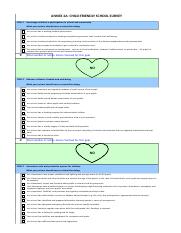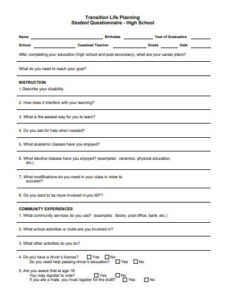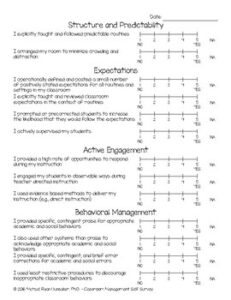Understanding what makes high school students tick, what challenges they face, and what truly enriches their educational journey is more vital than ever. Schools constantly strive to create an environment where every student feels supported, engaged, and ready to learn. But how do you genuinely gauge if you’re hitting the mark? Relying on anecdotal evidence or assumptions can only take you so far. What’s needed is a structured, comprehensive approach to gather honest and constructive feedback directly from the source: the students themselves.
This is where a robust high school student satisfaction survey template becomes an invaluable asset. It’s not just about collecting data; it’s about opening a clear channel of communication that empowers students’ voices and provides actionable insights for school administrators, teachers, and staff. By systematically asking the right questions, you can uncover areas of success to celebrate and pinpoint opportunities for growth and improvement, ensuring your efforts truly resonate with the student body.
Why Gathering Student Feedback is Crucial for High Schools
Student satisfaction isn’t merely a metric; it’s a foundational element of a thriving educational ecosystem. When students feel satisfied with their school experience, they are more likely to be engaged in their studies, participate in school activities, and ultimately achieve greater academic success. Happy students also contribute to a positive school culture, which can reduce disciplinary issues and improve overall morale among both students and staff. Investing in understanding student perspectives through dedicated surveys shows a commitment to their well-being and development.
Moreover, feedback acts as an early warning system. Issues that might otherwise fester and lead to disengagement or even attrition can be identified and addressed proactively. Whether it’s concerns about bullying, challenges with a particular subject, or a lack of desired extracurricular options, a well-designed survey can bring these points to light. This allows schools to intervene with targeted support and adjustments, preventing minor frustrations from escalating into significant problems that impact the learning environment.
Empowering student voices through a formal feedback mechanism builds a stronger sense of community and ownership. When students realize their opinions are valued and can genuinely influence school policies or programs, they become more invested stakeholders in their own education and the collective success of the school. This sense of agency fosters responsibility and encourages active participation, transforming students from passive recipients of education into active co-creators of their learning environment.
Finally, the data gleaned from student satisfaction surveys provides invaluable, evidence-based insights for strategic planning and resource allocation. Instead of relying on gut feelings or assumptions, administrators can make informed decisions about curriculum adjustments, professional development for teachers, improvements to facilities, or expansion of support services. This data-driven approach ensures that limited resources are directed towards areas where they will have the most significant positive impact, leading to continuous improvement and a more effective educational experience for everyone.
Key Areas a Survey Should Cover
- Academic Support: Questions about the helpfulness of teachers, availability of tutoring, and clarity of assignments.
- School Environment and Safety: Inquiries regarding feelings of safety, cleanliness of facilities, and presence of a welcoming atmosphere.
- Teacher Effectiveness: Feedback on teaching styles, ability to explain complex topics, and approachability of instructors.
- Extracurricular Activities: Assessments of the variety and quality of clubs, sports, and other after-school programs.
- Communication: Questions about how well the school communicates with students regarding important information, events, and changes.
- Mental Health Support: Opinions on the availability and effectiveness of counseling services and emotional support resources.
Crafting Your Effective High School Student Satisfaction Survey Template
Moving beyond the “why,” the real power lies in the “how” – how to design and implement a high school student satisfaction survey template that yields truly useful and actionable data. The effectiveness of your survey hinges on several key design principles, starting with clarity and relevance. Each question should be straightforward, easy for students to understand, and directly related to an area where you seek feedback. Ambiguous questions or those that combine multiple ideas can lead to confusing responses and unreliable data.
A well-crafted survey will also incorporate a variety of question types to capture different dimensions of student experience. Likert scales (e.g., “strongly agree” to “strongly disagree”) are excellent for quantifying opinions on specific statements, allowing for easy comparison and trend analysis. However, don’t shy away from open-ended questions. These qualitative prompts provide students with the opportunity to elaborate on their experiences, offering rich insights, personal anecdotes, and suggestions that quantitative data alone cannot capture. Anonymity is also paramount; ensuring students feel safe to express their honest opinions without fear of reprisal will significantly increase response rates and the candor of feedback.
Once your high school student satisfaction survey template is ready, effective administration and promotion are crucial for maximizing participation. Clearly communicate the purpose of the survey to students – explain that their feedback is genuinely valued and will be used to make positive changes. Provide a convenient and accessible platform for completion, such as an online survey tool. Consider timing the survey strategically, perhaps mid-semester or towards the end of the academic year, when students have had ample experience to form their opinions. Incentives, even small ones, can also encourage greater participation.
Finally, collecting the data is only the first step. The true impact comes from analyzing the results, identifying key themes and trends, and most importantly, acting on the feedback received. Share a summary of the findings with students and the wider school community, demonstrating that their input was heard and valued. Then, develop a clear action plan based on the insights. Whether it’s adjusting a policy, introducing a new program, or providing additional training for staff, showing tangible results of the survey process closes the feedback loop and reinforces the message that student voices truly matter.
Empowering Voices for a Better School
Proactive engagement with student feedback is a hallmark of truly progressive and student-centered high schools. By consistently utilizing a well-designed survey, educational institutions gain an unparalleled window into the student experience, allowing them to adapt, improve, and innovate in ways that directly address the needs and aspirations of their student body. This commitment to listening not only enhances the quality of education but also fosters a stronger, more supportive, and ultimately more successful learning environment for everyone involved.
Embracing the insights gleaned from student satisfaction surveys is an ongoing journey of continuous improvement. It’s about building a culture where student voices are not just heard, but actively sought out and acted upon, shaping an educational landscape where every student can thrive and feel a genuine sense of belonging.



